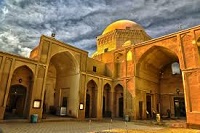The Music Museum of Shiraz: A Journey Through Iran’s Musical Heritage
Shiraz, a city renowned for its historical richness and cultural depth, is home to numerous architectural marvels and historical landmarks. Among its many treasures is the Music Museum of Shiraz, located within the Manotegh Nezhad House, a stunning example of Qajar-era architecture. This museum offers an immersive exploration of the rich and diverse musical heritage of Iran, celebrating both traditional and contemporary music through its fascinating exhibits.
The house, built during the Qajar dynasty, was registered as one of Iran’s national heritage sites in 1973. The Music Museum not only highlights the cultural significance of music in Persian society but also serves as a beacon for preserving and promoting the history of music across the nation.
Historical Background of Manotegh Nezhad House
The Manotegh Nezhad House, an exquisite historical building, is one of the architectural jewels of Shiraz. Built during the Qajar period, it is a prime example of Persian residential architecture. The house has a central courtyard surrounded by several rooms, with the Shah-neshin (main seating area) being a notable feature. The building is divided into eastern and western wings, each of which contains various rooms designed for specific purposes, showcasing the functional yet beautiful architectural style of the era.
In 1973, the house was designated as a national monument, recognizing its cultural and architectural significance. Over time, the building was converted into the Music Museum of Shiraz, offering visitors a unique chance to explore not only the house’s historical beauty but also the profound influence of music in Persian culture.
Museum’s Sections and Exhibits
The Music Museum of Shiraz is a multi-faceted space that brings the diverse and rich history of music to life. Each section of the museum offers insight into different aspects of Iranian music, making it a must-visit destination for both music lovers and history enthusiasts. Below are the main sections of the museum:
1. Music of the World
This section highlights the global diversity of music. Visitors can learn about various international musical traditions, showcasing instruments and performances from different cultures. This part of the museum serves as a reminder of the universal language of music, bridging the cultural divides between nations and celebrating the shared human experience.
2. Traditional Iranian Instruments
The heart of the museum is dedicated to Iranian music, with a particular focus on the country’s iconic instruments. This section features a range of traditional Persian instruments, such as the tar, setar, kamancheh, and ney. These instruments are central to classical Persian music and have been passed down through generations. Detailed descriptions of each instrument’s history, construction, and use offer visitors a comprehensive understanding of Iran’s musical heritage.
3. Music Studio and Education Section
The museum features a music studio where visitors can observe live performances or recordings. It is also a space where aspiring musicians can come to learn about music theory, composition, and performance. The museum offers workshops and lectures to promote music education, making it not only a place of learning about history but also a hub for modern music exploration.
4. Archive Room
The archive room houses an extensive collection of documents, photographs, and recordings that chronicle the history of Iranian music. This includes recordings of famous Persian musicians, composers, and vocalists, providing a fascinating look at the development of music in Iran. The audio archives are an invaluable resource for researchers and music enthusiasts interested in the evolution of Persian musical styles.
5. Iranian Musicians’ Hall
This section of the museum pays tribute to the legendary Iranian musicians who have shaped the country’s musical identity. The portraits, biographies, and contributions of these musicians are displayed, allowing visitors to learn more about their lives and impact on Persian music. Famous figures such as Ostad Abdollah Davami, Ostad Mohammad Reza Shajarian, and many others are honored here.
6. Sound Archive and Recording Vault
The museum’s sound archive is dedicated to preserving rare musical recordings, which include performances by traditional musicians, folk singers, and modern composers. The audio vault is a treasure trove for music lovers, offering a glimpse into the evolution of Persian music and the various regional styles and traditions that make it so rich and diverse.
Cultural Significance of the Music Museum
Iran has a long and proud history of music, and the Music Museum of Shiraz plays an essential role in preserving and showcasing that legacy. Music is an integral part of Iranian culture, with traditional music being a reflection of the country’s values, philosophies, and poetic heritage. The museum helps visitors connect with Iranian music at a deeper level by offering access to its historical roots as well as its modern-day expressions.
Shiraz, with its poetic history and artistic atmosphere, is the perfect setting for such a museum. The city has long been a cultural hub, home to famous poets like Hafez and Saadi, whose works are often sung or recited to the accompaniment of music. The museum’s focus on Iranian musical heritage underscores the city’s significance in the broader context of Persian arts and culture.
Conclusion
The Music Museum of Shiraz at the Manotegh Nezhad House is an exceptional cultural institution that offers a comprehensive look into the musical heritage of Iran. Through its vast collections, educational programs, and interactive exhibits, the museum not only highlights the beauty and diversity of Persian music but also serves as a hub for the preservation and promotion of this timeless art form.
For anyone visiting Shiraz, this museum is a must-see, offering an educational and immersive experience that delves into the world of Iranian music. It’s a place where visitors can connect with the sounds, rhythms, and stories that have shaped the musical culture of one of the oldest civilizations in the world.



